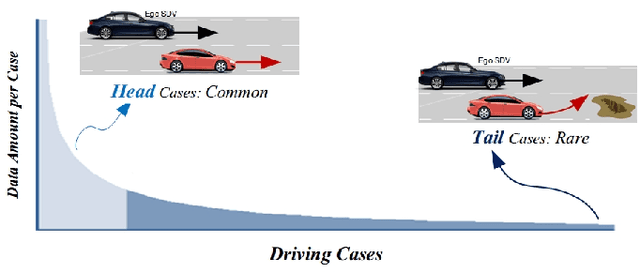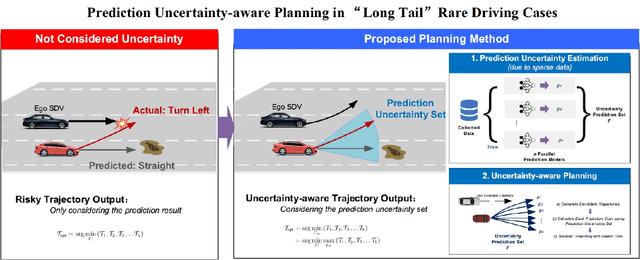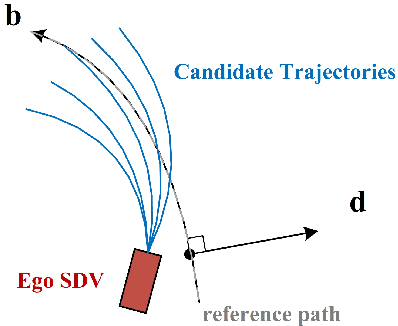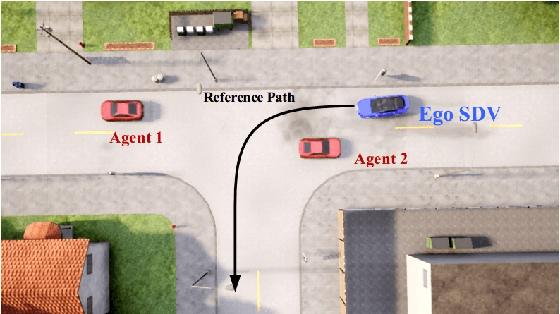Nanshan Deng
Dynamically Local-Enhancement Planner for Large-Scale Autonomous Driving
Feb 28, 2025Abstract:Current autonomous vehicles operate primarily within limited regions, but there is increasing demand for broader applications. However, as models scale, their limited capacity becomes a significant challenge for adapting to novel scenarios. It is increasingly difficult to improve models for new situations using a single monolithic model. To address this issue, we introduce the concept of dynamically enhancing a basic driving planner with local driving data, without permanently modifying the planner itself. This approach, termed the Dynamically Local-Enhancement (DLE) Planner, aims to improve the scalability of autonomous driving systems without significantly expanding the planner's size. Our approach introduces a position-varying Markov Decision Process formulation coupled with a graph neural network that extracts region-specific driving features from local observation data. The learned features describe the local behavior of the surrounding objects, which is then leveraged to enhance a basic reinforcement learning-based policy. We evaluated our approach in multiple scenarios and compared it with a one-for-all driving model. The results show that our method outperforms the baseline policy in both safety (collision rate) and average reward, while maintaining a lighter scale. This approach has the potential to benefit large-scale autonomous vehicles without the need for largely expanding on-device driving models.
Identify, Estimate and Bound the Uncertainty of Reinforcement Learning for Autonomous Driving
May 12, 2023Abstract:Deep reinforcement learning (DRL) has emerged as a promising approach for developing more intelligent autonomous vehicles (AVs). A typical DRL application on AVs is to train a neural network-based driving policy. However, the black-box nature of neural networks can result in unpredictable decision failures, making such AVs unreliable. To this end, this work proposes a method to identify and protect unreliable decisions of a DRL driving policy. The basic idea is to estimate and constrain the policy's performance uncertainty, which quantifies potential performance drop due to insufficient training data or network fitting errors. By constraining the uncertainty, the DRL model's performance is always greater than that of a baseline policy. The uncertainty caused by insufficient data is estimated by the bootstrapped method. Then, the uncertainty caused by the network fitting error is estimated using an ensemble network. Finally, a baseline policy is added as the performance lower bound to avoid potential decision failures. The overall framework is called uncertainty-bound reinforcement learning (UBRL). The proposed UBRL is evaluated on DRL policies with different amounts of training data, taking an unprotected left-turn driving case as an example. The result shows that the UBRL method can identify potentially unreliable decisions of DRL policy. The UBRL guarantees to outperform baseline policy even when the DRL policy is not well-trained and has high uncertainty. Meanwhile, the performance of UBRL improves with more training data. Such a method is valuable for the DRL application on real-road driving and provides a metric to evaluate a DRL policy.
Dynamically Conservative Self-Driving Planner for Long-Tail Cases
May 12, 2023



Abstract:Self-driving vehicles (SDVs) are becoming reality but still suffer from "long-tail" challenges during natural driving: the SDVs will continually encounter rare, safety-critical cases that may not be included in the dataset they were trained. Some safety-assurance planners solve this problem by being conservative in all possible cases, which may significantly affect driving mobility. To this end, this work proposes a method to automatically adjust the conservative level according to each case's "long-tail" rate, named dynamically conservative planner (DCP). We first define the "long-tail" rate as an SDV's confidence to pass a driving case. The rate indicates the probability of safe-critical events and is estimated using the statistics bootstrapped method with historical data. Then, a reinforcement learning-based planner is designed to contain candidate policies with different conservative levels. The final policy is optimized based on the estimated "long-tail" rate. In this way, the DCP is designed to automatically adjust to be more conservative in low-confidence "long-tail" cases while keeping efficient otherwise. The DCP is evaluated in the CARLA simulator using driving cases with "long-tail" distributed training data. The results show that the DCP can accurately estimate the "long-tail" rate to identify potential risks. Based on the rate, the DCP automatically avoids potential collisions in "long-tail" cases using conservative decisions while not affecting the average velocity in other typical cases. Thus, the DCP is safer and more efficient than the baselines with fixed conservative levels, e.g., an always conservative planner. This work provides a technique to guarantee SDV's performance in unexpected driving cases without resorting to a global conservative setting, which contributes to solving the "long-tail" problem practically.
Long-Tail Prediction Uncertainty Aware Trajectory Planning for Self-driving Vehicles
Jul 02, 2022



Abstract:A typical trajectory planner of autonomous driving usually relies on predicting the future behavior of surrounding obstacles. In recent years, prediction models based on deep learning have been widely used due to their impressive performance. However, recent studies have shown that deep learning models trained on a dataset following a long-tailed driving scenario distribution will suffer from large prediction errors in the "tails," which might lead to failures of the planner. To this end, this work defines a notion of prediction model uncertainty to quantify high errors due to sparse data. Moreover, this work proposes a trajectory planner to consider such prediction uncertainty for safer performance. Firstly, the prediction model's uncertainty due to insufficient training data is estimated by an ensemble network structure. Then a trajectory planner is designed to consider the worst-case arising from prediction uncertainty. The results show that the proposed method can improve the safety of trajectory planning under the prediction uncertainty caused by insufficient data. At the same time, with sufficient data, the framework will not lead to overly conservative results. This technology helps to improve the safety and reliability of autonomous vehicles under the long-tail data distribution of the real world.
 Add to Chrome
Add to Chrome Add to Firefox
Add to Firefox Add to Edge
Add to Edge